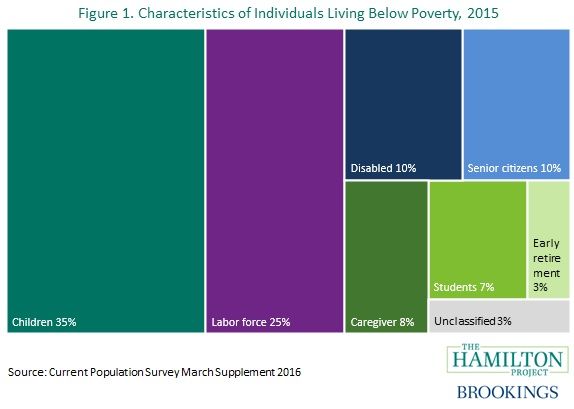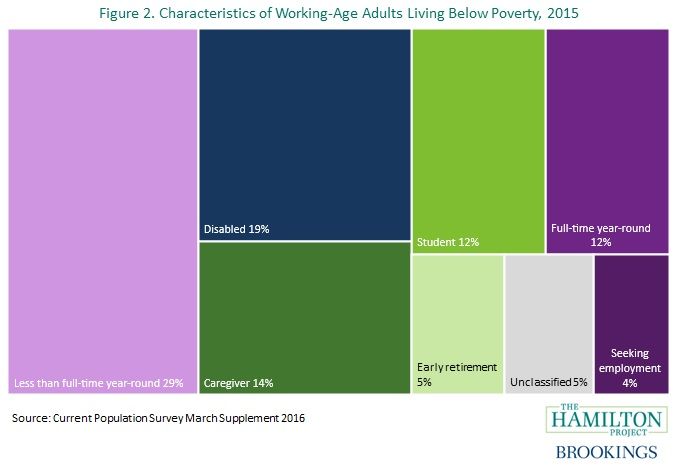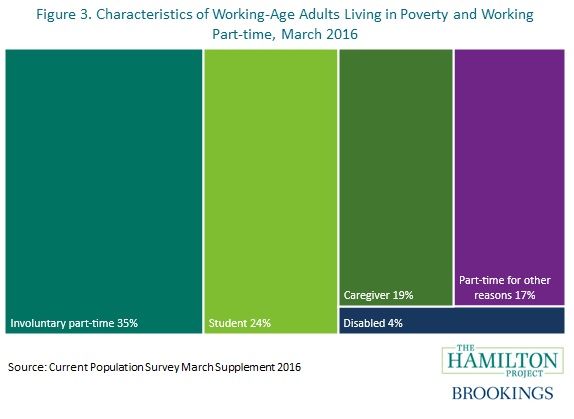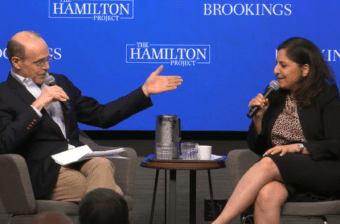Recently, the Census Bureau released its annual report on poverty. The report showed that the official rate of poverty in 2015 was 13.5%, down 1.2 percentage points from 2014. Using the Current Population Survey March Supplement, the data used for the Census poverty report, we update our recent analysis to describe the characteristics of the poor in 2015 and changes in these characteristics over the last year.
The characteristics of individuals living in poverty did not change substantially from 2014 to 2015. Children still comprise more than a third of those living below poverty and students an additional 7 percent. A quarter of those living below the poverty threshold are in the labor force, either working or searching for work. Senior citizens, early retirees, the disabled, and caregivers constitute the remaining thirty percent of those living in poverty. Only 3 percent of those living in poverty fall outside of the groups just mentioned.
There were small shifts in the composition of who is poor from 2014 to 2015. Children (+0.3 percentage points), students (+0.3 percentage points), and the disabled (+0.4 percentage points) saw small increases in their shares of those living in poverty while working-age adults in the labor force (-0.4 percentage points), caregivers (-0.3 percentage points), and early retirees (-0.4 percentage points) saw slight declines.

Next we examine the characteristics of working-age adults living in poverty. Just over 11.5 percent of working-age adults living in poverty are working full-time year-round, a 1.2 percentage point decrease in the share from 2014 to 2015. As detailed in last week’s poverty report, earnings rose for those working full-time year-round, helping to raise many out of poverty. There were also decreases in the share of working-age adults seeking employment (-0.9 percentage points), caregivers (-0.5 percentage points), and early retirees (-0.6 percentage points). There were increases in the share of working-age adults living in poverty who were employed less than full-time year-round (+1.7 percentage points), the share who were students (+0.5 percentage points), and the share who were disabled (+0.8 percentage points). Only five percent of working-age adults in poverty were not members of the groups just mentioned.

Finally, we look at the characteristics of working-age adults living in poverty who reported usually working part-time in 2015 and were still working part-time in March 2016. The largest increase in the share of part-time workers living in poverty was among students, which saw just over a one-and-a-half percentage point increase. By contrast, we see an almost four percentage point decrease in the share of adults working part-time involuntarily, though this group still represents more than a third of those living in poverty and working part-time. This decrease reflects the ongoing strengthening in the labor market, which resulted in a sharp drop from 2014 to 2015 in the overall number of those working part-time who would have preferred full-time employment.

In order to address poverty, we must know who is poor and how the composition of who is poor is changing. This analysis describes who was living in poverty in 2015 and how that changed from the prior year. As with our analysis of poverty in 2014, this update suggests that when poor working-age adults are not employed full-time, they are often disabled, receiving education, or engaged in caregiving.




